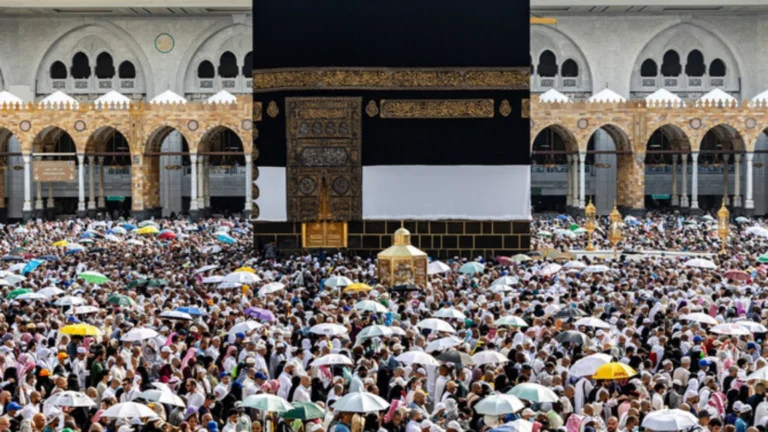Saudi Arabia Railways has increased the capacity of the Haramain High-Speed Railway by 400,000 new seats ahead of 2025 Hajj season. This move is almost pushing the total capacity of seats to two million. It is an indication of the kingdom’s attempt to cope with a big increase in the number of pilgrims. The expansion arrives at the perfect time for peak travel days when millions of Muslims travel between Makkah and Madinah. More space and comfort will be experienced by the passengers when on their sacred pilgrimage.
From April 29, the railway will make 4 768 special trips, stretched along a 453 km length. Five major stations will have trains departing from them. Makkah, Madinah, Jeddah’s Sulaymaniyyah station, the station for the King Abdulaziz International Airport, the station for the King Abdullah Economic City. The line acts as fast, dependable connection that instead of long, jammed bus rides. It will minimize road traffic and reduce congestion on highways that are so choked during Hajj.
The Haramain trains can go up to 300 km/h. Traveling at that speed the trip time from Makkah to Madinah is reduced to approximately 2 hours. Pilgrims are now able to spend less time on their way, and have more time for worship/shows. The railway is powered by electricity. It produces no carbon emissions. Every one of its trains (35 trains) accommodates 417 passengers. The whole fleet provides a modern, green travel alternative which fits Saudi Arabia’s drive to establish sustainable infrastructure.
Officials report that the new seats will accommodate both domestic and international pilgrims. They believe the new slots will be filled fast. The number of Hajj quotas by many countries has risen. Pilgrim numbers may well outstrip last year’s levels by a margin. Much of that growth will be absorbed by the extra seats. They will also provide a backup for the unforeseen delays or technical malfunctioning. Where one train breaks down another can replace it and little service gaps would be created.
Saudi Vision 2030 underpins this upgrade. Under the plan, all sectors are to have improved infrastructure. It also explains quality services for the residents and visitors. This pilgrimage is one of top priorities of the kingdom. It causes annual arrival of religious tourists. The new railway capacity represents a wider mission to modernise transport. It wants to demonstrate Saudi Arabia as a leader in new rail technology.
The passengers will enjoy state of the art facilities on board. Every train has air-conditioned trains cars, free Wi-Fi and comfortable seats. Pilgrims will be helped with the luggage and boarding by the staff. Service teams will be using several languages to help international travellers. The stations will have prayer areas, waiting lounges and information desks. These facilities will facilitate contemplation and the preparation of pilgrims for their spiritual quest peacefully and orderly.
Safety remains a major focus. Rail authorities have carried out intensive testing of the new seats and cars. They have tested the trials trips at full capacity to test the system performance under pressure. Engineers have included additional safety measures for electrical failure or bad weather. They have also taught station crews and conductors on emergency protocols. In the event such a situation arises, staff will lead passengers to safety using simple instructions.
The network connects to other transport as well. Pilgrims, from the Jeddah airport station can board a flight or move to city buses. The King Abdullah Economic City station connects to local taxis and to ride share facilities. The entire system functions like an integrated network of travel alternatives. Pilgrims can change from plane to train to bus. They can plan their routes and reserve tickets while online. The integrated ticketing platform supports all of the main legs of the journey.
Local businesses will benefit too. Shops and restaurants are established around important stations. It is their vision to serve pilgrims coming and going from train rides. Vendors provide travel necessities, food and candies. Islamic books and prayer beads are listed by some outlets. Others produce local crafts and souvenirs. This commerce offers job opportunities in the holy regions and contributes to the economy on the spot.
The project’s pace and scope has been admired by observers. They note that this involves adding nearly half a million seats, which is something of a logistical coup. It called for intimate coordination between rail engineers, government bodies and contractors. The efforts also include improvement of electrical lines and platform at stations. Workers toiled 24 hours a day to work within tight deadlines. Their success represents an increasing competency by Saudi Arabia in the large scale infrastructure project.
Before Hajj, pilgrims will test the new capacity. This initial feedback will help improve in the future. Authorities have vowed to monitor crowd movements and make on the spot schedules. They are planning to review data on train usage and boat ride satisfaction. This feedback loop will help to mould next years service plans.
Over all the addition of 400,000 seats represents a major push to Haramain Railway’s position in Hajj operations. It provides the pilgrims with a quicker yet greener and more comfortable passage between two of Islam’s most holy cities. It also highlights Saudi Arabia’s passion for modern transport and sustainable development. The upgrade raises the new benchmark of pilgrimage logistics and serves the kingdom’s longer vision of growth and innovation.










